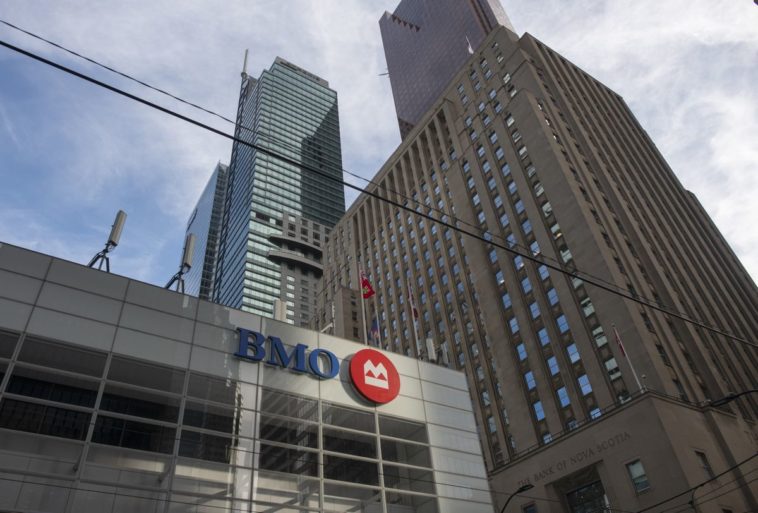Banks expected to report lower profits this week
/cloudfront-us-east-1.images.arcpublishing.com/tgam/JD2KLMNGQNGAFJEWUQMC6WHJMI.jpg)
The Bank of Montreal branch, left, and Scotiabank building, left, at King St. West and Bay St. in Toronto’s Financial District on Sept. 3, 2020.
Fred Lum/The Globe and Mail
The glass looks both half full and half empty for Canada’s large banks as they prepare to report fourth-quarter financial results this week, capping off a tempestuous fiscal year.
The good news is that fears about a possible wave of loan defaults have eased, though not disappeared, after the recent expiry of hundreds of thousands of payment deferrals. Analysts expect banks to top up their reserves to cover future losses, after they collectively earmarked $17.7-billion in new provisions for credit losses over the past two quarters. But no new major surge in provisions is expected, even as cases of the novel coronavirus spike and some parts of Canada’s economy are locked down once again.
On the other hand, banks’ revenues are under pressure on multiple fronts. Persistently low interest rates are lowering the margins banks earn from lending. There is weaker demand for new loans in categories that earn higher returns, such as commercial lending. And banks are awash in deposits that can also eat into margins as clients stash away cash to ride out the pandemic.
All told, analysts expect profits to continue to fall, with earnings per share declining anywhere from 16 per cent to 20 per cent when compared with the same quarter a year ago, by some estimates. But attention will likely shift to how banks plan to chart a court back to higher profits over the coming year.
“As credit concerns de-escalate, investors have become more focused on growth issues facing the sector,” said Gabriel Dechaine, an analyst at National Bank Financial Inc., in a note to clients.
Those investors will be looking for “any bank that demonstrates revenue momentum,” he added.
Revenues from fees, which have been hit hard by economic lockdown measures, have shown early signs of rebounding, but could “remain sluggish given changing spending patterns and [a] higher savings rate,” said Meny Grauman, an analyst at Scotia Capital Inc., in a research note. And revenue from capital markets, which have buoyed banks’ profits with record results over the past two quarters as the pandemic created havoc in markets, are expected to ease back to more normal levels.
With limited options to increase revenues, banks are also expected to keep a sharp eye on costs, and multiple analysts said they have not ruled out the potential for some banks to take restructuring charges. The most likely candidates, according to Mr. Mihelic, are Bank of Nova Scotia or National Bank of Canada, after Bank of Montreal and Canadian Imperial Bank of Commerce each recorded such charges within the past year.
In the near-term, the drag on profits as banks have stocked up on provisions for credit losses – funds set aside to cover loans that may not be repaid in future – should continue to ease. Darko Mihelic, an analyst at RBC Dominion Securities Inc., estimates that banks could set aside another $4.5-billion in provisions in the fourth quarter, which would be a 26-per-cent decrease from the previous three months – but still 89-per-cent higher than a year ago.
Promising early results from multiple vaccine trials, combined with the prospect of greater stability and predictability in the United States under president-elect Joe Biden, “have reduced the benefit of having additional reserves for downside scenarios,” said Paul Holden, an analyst at CIBC World Markets Inc.
But the health of the banks’ loan books is clouded by uncertainty about the severity of a recent surge of COVID-19 infections, which has prompted some provincial governments to reimpose stricter limits on businesses and tighter physical distancing guidelines.
In that context, growing stores of capital held by all six banks are a comforting trend. Analysts expect the banks’ average common equity Tier 1 (CET1) ratio – a key measure of their capacity to absorb losses and continue lending – will rise about 20 basis points to a robust 11.9 per cent (100 basis points equal one percentage point). Canada’s banking regulator recently signalled that it is in no hurry to lift restrictions that prevent banks from raising dividend payments or buying back shares.
With banks sitting on substantial excess capital, and mergers and acquisitions among banks picking up in the U.S. – most recently, PNC Financial Services Group, Inc. acquired the U.S. subsidiary of Banco Bilbao Vizcaya Argentaria SA for US$11.6-billion this month – “We believe banks will face more and more questions about potential deals,” Mr. Dechaine said. “In our view, TD [Toronto-Dominion Bank] and BMO are the most likely to make U.S. regional bank acquisitions.”
Your time is valuable. Have the Top Business Headlines newsletter conveniently delivered to your inbox in the morning or evening. Sign up today.
Published at Sun, 29 Nov 2020 23:42:30 +0000





Comments
Loading…